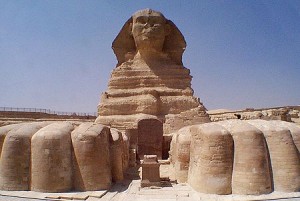World’s Largest Single-Stone Statue
The Great Sphinx is the huge monolithic statue of a human-headed lion that was carved into a single mass of limestone bedrock on the western bank of the Nile during the third millennium BCE. The Sphinx faces directly east and its stonework features once included a cobra-embellished headdress and a beard.
Though neither the Sphinx nor its principal architect were cited within the content of any hieroglyphs from the time, the ‘foreman’ of the project is widely regarded to be Pharaoh Khafre (c. 2558-2532 BCE), the ruler of the Old Kingdom, which was a period of early Egyptian civilisation that endured for 2,500 years. Incidentally, Khafre’s father- Khufu (c. 2589-2566 BCE) -built the Great Pyramid at Giza approximately 400 metres (1,300 feet) from where the Sphinx statue would later be carved.
Regarding the identity of the labour force, an Old Kingdom cemetery containing the tombs of some 600 possible workers and overseers was unearthed in the early-Nineties.
Following that, in 1999 Egyptian archaeologist Mark Lehner found a settlement dating back to the reign of Khafre, capable of accommodating between 1,600 and 2,000 people -a rather convenient Sphinx construction workforce, perhaps?
 4,500 years ago, before bronze and iron were prevalent, the available tools for this colossal undertaking would have included copper implements and stone hammers. Modern reconstructions, using similar stone and ancient-style tools, have estimated that the Sphinx could have been constructed in just three years with 100 people chipping away at a rate of 0.03 cubic metres (one cubic foot) per week.
4,500 years ago, before bronze and iron were prevalent, the available tools for this colossal undertaking would have included copper implements and stone hammers. Modern reconstructions, using similar stone and ancient-style tools, have estimated that the Sphinx could have been constructed in just three years with 100 people chipping away at a rate of 0.03 cubic metres (one cubic foot) per week.
Using the huge excavation of stone quarried away from the Sphinx enclosure (the pit in which the statue sits), the labourers were also able to construct the nearby Sphinx Temple. Each block that was removed from the Sphinx statue site could have weighed up to 200 tons and would have been transported on rollers.
Until the Thirties, when an archaeologist called Selim Hassan excavated the lower half of the statue, the Great Sphinx remained buried up to its shoulders by sand. Today it stands proud alongside the other monuments of Giza as a testament to the engineering skill of the Ancient Egyptian civilization.

